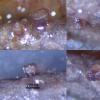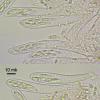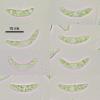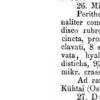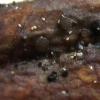
07-12-2025 16:07
Arnold BüschlenHallo, ich habe in einer Moos-Aufsammlung (epiohy

05-12-2025 17:33
 Bruno Coué
Bruno Coué
Bonjour, je serais heureux de recueillir votre avi

07-12-2025 09:24
De la pasada semana en Galicia EspañaEn el suelo

06-12-2025 00:19
 Viktorie Halasu
Viktorie Halasu
Hello, would anyone have this article, please? An

02-12-2025 18:59
This pair of ascos 2.5cm across were on recently b
There is one amazing species i found with rare occurence on fallen leaves of Ledum palustre. I am not sure about its generic position.
Collection coordinate: N60,893151° E68,679313°, 19.06.2014.
Apothecia turbinate to cupulate, sessile, brown, reddish-brown at base, blackish when dry, hymenium light brown, up to 200 mk high, 250 mk broad, scattered at both leaf surfaces.
Excipulum from angular thick-walled brown cells (6-12 mk) at base and middle part, amorphous in upper part where covered by brown incrustation, the very base from labirynthuloid cells; asci clavate, without crozier, with euamyloid ring, 77.5-87 x 10.4-13 mk; paraphyses cylindrical at base (2 mk), enlarged at tip up to 4 mk, rarely branched, with greenish vacuoles in upper part, turning reddish-brown in YKY, tips embedded in gel and glued together; spores fusoid, more or less cuved, with many small guttules, 16.2 (14.5-19.4) x 3.6 (3.3-4) (n=13).

this is obviously a Micropeziza (= Calloriella).
see our paper in attachment
Zotto

this is obviously a Micropeziza (= Calloriella).
see our paper in attachment
Zotto
thank you for the paper. I have made a first quick look in there and in the related posts at the forum. Seems there is no quite matching species with such ecology, spore curvature and size. But probably it is close to M. cornea. I suppose it should be studied later in depth.
Looking in host-fungus database SMML i noticed Micropeziza fuscidula described by Rehm (1882) on Rhododendron ferrugineum. It was transferred to Cashiella fuscidula. And the spores in the prior description are shorter (9/2). Could you possibly know this species?
Nina.

No, I do not even have this fuscidula in my database. I am not sure whether I have a reprint of
Cashiella fuscidula (Rehm) E. Müll., Beitr. Kryptfl. Schweiz 15(no. 1): 30 (1977)
Zotto

I don't have Müller, E. 1977. Zur Pilzflora der Aletschwaldreservats (Kt. Wallis, Schweiz). Beiträge zur Kryptogamenflora der Schweiz. 15(1):1-126
All I can contribute is Rehm's protologue (attached) where he describes the spores as "subcurvata" which possibly matches (but shorter). But he mentions that iodine-reaction of the ascal apparatus is negative!
Best regards
Martin
I hope that one day we will know what species it is exactly ).
here is the desciption and the drawing of Cashiella fuscidula (Rehm) E. Müll., Beitr. Kryptfl. Schweiz 15(no. 1): 30 (1977), see attached file.
Best, Uwe

Zotto

